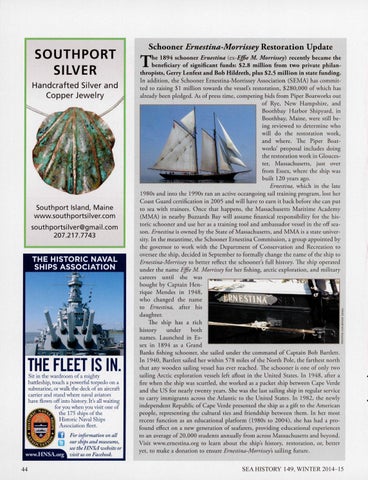SOUTHPORT SILVER Handcrafted Silver and Copper Jewelry
Southport Island, Maine www.southportsilver.com southportsilver@gmail.com 207 .217.7743
THE FLEET IS IN. Sit in the wardroom of a mighty battleship, touch a powerful torpedo on a submarine, or walk the deck of an aircraft carrier and stand where naval aviators have flown off into history. It's all waiting for you when you visit one of ~!Ill~ the 175 ships of the Historic Naval Ships Association fleet.
For information on all our ships and museums, see the HNSA website or www.HNSA.org visit us on Facebook.
44
Schooner Ernestina-Morrissey Restoration Update
T
he 1894 schooner Ernestina (ex-Effie M. Morrissey) recently became the beneficiary of significant funds: $2.8 million from two private philanthropists, Gerry Lenfest and Bob Hildreth, plus $2.5 million in state funding. In addition, the Schooner Ernestina-Morrissey Association (SEMA) has committed to raising $1 million towards the vessel's restoration, $280,000 of which has already been pledged. As of press time, competing bids from Piper Boatworks out of Rye, New Hampshire, and Boothbay Harbor Shipyard, in Boothbay, Maine, were still being reviewed to determine who will do the restoration work, and where. The Piper Boatworks' proposal includes doing the restoration work in Gloucester, Massachusetts, just over from Essex, where the ship was built 120 years ago. Ernestina, which in the late 1980s and into the 1990s ran an active oceangoing sail training program, lost her Coast Guard certification in 2005 and will have to earn it back before she can put to sea with trainees. Once that happens, the Massachusetts Maritime Academy (MMA) in nearby Buzzards Bay will assume finanical responsibility for the historic schooner and use her as a training tool and ambassador vessel in the off season. Ernestina is owned by the State of Massachusetts, and MMA is a state university. In the meantime, the Schooner Ernestina Commission, a group appointed by the governor to work with the Department of Conservation and Recreation to oversee the ship, decided in September to formally change the name of the ship to Ernestina-Morrissey to better reflect the schooner's full history. The ship operated under the name Effie M. Morrissey for her fishing, arctic exploration, and military careers until she was bought by Captain Henrique Mendes in 1948, who changed the name to Ernestina, after his daughter. The ship has a rich history under both names. Launched in Essex in 1894 as a Grand Banks fishing schooner, she sailed under the command of Captain Bob Bartlett. In 1940, Bartlett sailed her within 578 miles of the North Pole, the farthest north that any wooden sailing vessel has ever reached. The schooner is one of only two sailing Arctic exploration vessels left afloat in the United States. In 1948, after a fire when the ship was scuttled, she worked as a packet ship between Cape Verde and the US for nearly twenty years. She was the last sailing ship in regular service to carry immigrants across the Atlantic to the United States. In 1982, the newly independent Republic of Cape Verde presented the ship as a gift to the American people, representing the cultural ties and friendship berween them . In her most recent function as an educational platform (1980s to 2004), she has had a profound effect on a new generation of seafarers, providing educational experiences to an average of 20,000 students annually from across Mas:sachusetts and beyond. Visit www.ernestina.org to learn about the ship's history, restoration, or, better yet, to make a donation to ensure Ernestina-Morrissey's sailing future . SEAHISTORY 149, WINTER2014- 15
